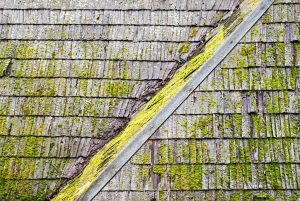When you are driving down any street in Wisconsin, check the roofs of buildings. There is a likelihood of seeing several roofs with brown or black marks. Many property owners mistake this for moss or mold. What you are seeing in real sense is a protective layer against sun rays. Algae that go by the name Gloeocapsa magma form it. People often refer to this tough coating as blue-green algae. If you see this coating on the neighbor’s roof, yours could be next in line. What do you do to counter the algae? How does it affect the roof even?
Effect on Roof
If you have ever visited a river or lake infested by blue-green algae, then you know how unsightly the picture can be. The presence of these organisms on the roof of a commercial or residential building is a justified cause for concern. After all, the roof is the first line of defense against elements. Any problem with the roof and everything else inside the house goes awry. Fortunately, studies have come out to dispute physical damage on some types of roofs, asphalt shingles included. However, this growth can affect the reflective capability of a “cool” roof. Perhaps a reason for every homeowner to get rid of the marks is deterioration in curb appeal. If you ask any commercial roof installation contractor, stains on the roof do not do any justice to the value of a property.
Blue-Green Algae Removal
Fortunately, removing blue-green algae from the roof is a simple process. Many removal methods have been tried, but it appears that the most effective is a bleach solution. Armed with a garden sprayer, climb onto the roof (remember roof safety first) and spray the affected sections. Allow the solution to settle for fifteen minutes, and then soak the sections with clean water. Observe a simple but highly essential technique; spray in the natural water direction. Spraying against the roof slope can promote roof leaks and damage the roof further. If you have been planning to replace your asphalt shingle roof, this might be your perfect opportunity to install engineered asphalt. This roofing material is capable of warding off blue-green algae.
Preventive Measures to Try

Talking of prevention, some modern roofing materials come with copper ions that prevent growth of blue-green algae. Of course, implementing this solution might need a roof replacement, which can be expensive. On the alternative, routine roof maintenance may help. If so many tree branches cover your roof, consider trimming some of them back to allow for sunshine penetration. Debris and dirt settling on the roof for long encourage algae growth because they hold moisture. Remove them routinely and make sure the gutters are clean too. Growth of blue-green algae can also develop from the gutters.
While not entirely dangerous to the roof or property occupants, blue-green algae can have undesirable effects. Simple maintenance steps will remove the menace and prevent future invasions. Remember that if you are inexperienced in doing things on the roof, you need to consider hiring a professional for tasks suggested here.

